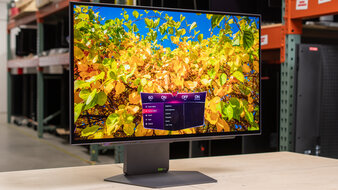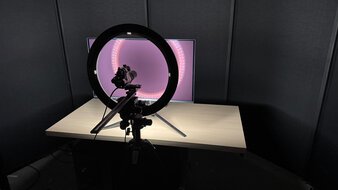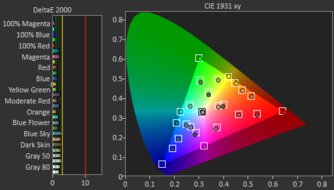A 240Hz monitor is beneficial for competitive gaming as it can provide better motion handling and lower input lag than displays with lower refresh rates. Although displays are coming out with higher refresh rates, there are still a good number of native 240Hz monitors available. They're available in various resolutions, from 1080p to 4k, and at different price points, so they're accessible for any budget.
When looking for a monitor, it's important to consider what type of gaming setup you have. If you have a high-end graphics card that maintains 240 fps with a high resolution, you'd benefit from a 1440p or 4k monitor. However, if you have a budget setup, then a lower-cost 1080p monitor is better, as your PC will be able to maintain high frame rates with the lower resolution. The monitor's response time is another consideration for sharp motion, and you'll want it to have low input lag for a responsive feel, but most monitors have low input lag. Besides that, most modern monitors support any type of VRR format to reduce screen tearing with various graphics cards.
We've bought and tested more than 375 monitors, and below are our recommendations for the best 240Hz monitors available. Check out our recommendations for the best G-SYNC monitors, the best high refresh rate monitors, and, if you prefer looking for something with a lower refresh rate, the best 144Hz monitors.
Quick Look






Looking to save on your next monitor? We've got you covered! Check out our Early Black Friday 2025 Deals article to see what's worthwhile this year.
-
Best 240Hz Monitor
 PC Gaming9.1Response Time9.9HDR Picture9.4SDR Picture10Brightness7.2Size27"Pixel TypeQD-OLEDNative Refresh Rate240 HzMax Refresh Rate240 HzSee all our test resultsNative Resolution3840 x 2160
PC Gaming9.1Response Time9.9HDR Picture9.4SDR Picture10Brightness7.2Size27"Pixel TypeQD-OLEDNative Refresh Rate240 HzMax Refresh Rate240 HzSee all our test resultsNative Resolution3840 x 2160The best 240Hz gaming monitor we've tested is the ASUS ROG Swift OLED PG27UCDM. It offers high-end performance and outstanding picture quality. While you need a premium setup to take advantage of its 240Hz refresh rate with a 4k resolution, what makes this such an amazing gaming monitor is that it has a near-instantaneous response time, resulting in minimal motion blur with fast-moving objects. It also supports the full bandwidth of both HDMI 2.1 and DisplayPort 2.1 to take full advantage of modern graphics cards and consoles.
Besides that, its QD-OLED panel delivers deep blacks in dark rooms without any blooming, but the black levels rise in bright rooms, making them look purple. On the plus side, it gets bright enough for colors to look vivid and highlights to pop, making for a fantastic HDR gaming experience, and it supports Dolby Vision. Its 27-inch screen and high resolution also result in high pixel density for sharp images, but if you want a bigger 32-inch QD-OLED, look into the ASUS ROG Swift OLED PG32UCDM. It performs similarly, but lacks DisplayPort 2.1 bandwidth.
-
Best Upper Mid-Range 240Hz Monitor
 PC Gaming9.1Response Time9.8HDR Picture9.2SDR Picture9.9Brightness7.8Size27"Pixel TypeOLEDNative Refresh Rate280 HzMax Refresh Rate280 HzSee all our test resultsNative Resolution2560 x 1440
PC Gaming9.1Response Time9.8HDR Picture9.2SDR Picture9.9Brightness7.8Size27"Pixel TypeOLEDNative Refresh Rate280 HzMax Refresh Rate280 HzSee all our test resultsNative Resolution2560 x 1440If you find that the ASUS ROG Swift OLED PG27UCDM is too expensive, check out the LG 27GX700A-B instead. It has a lower 1440p resolution, which requires less bandwidth from your graphics card to hit high frame rates, making it the best 1440p 240Hz monitor. Although it has a native 280Hz refresh rate, it still performs very well at 240Hz. This is because it has a near-instantaneous response time at any refresh rate, so motion looks sharp, and it has low input lag at any refresh rate as well. It uses the fourth-gen WOLED RGB Tandem panel, allowing it to get very bright, even brighter than the ASUS, so highlights really pop and it fights glare well.
However, there are a few trade-offs of getting it over the ASUS. It's less accurate in HDR as it prioritizes brightness over accuracy, and it's dimmer if you change to a more accurate picture mode. Its colors aren't as vivid as on the ASUS either. It also lacks a few features the ASUS has, like DisplayPort 2.1 bandwidth, but this doesn't make a big difference because you can still reach its max refresh rate without any sort of compression over DisplayPort.
-
Best Mid-Range 240Hz Monitor
 PC Gaming7.5Response Time7.9HDR Picture6.2SDR Picture6.8Brightness7.5Size27"Pixel TypeIPSNative Refresh Rate240 HzMax Refresh Rate240 HzSee all our test resultsNative Resolution2560 x 1440
PC Gaming7.5Response Time7.9HDR Picture6.2SDR Picture6.8Brightness7.5Size27"Pixel TypeIPSNative Refresh Rate240 HzMax Refresh Rate240 HzSee all our test resultsNative Resolution2560 x 1440If the LG 27GX700A-B is too much out of your price range, the ASUS ROG Swift PG279QM is a good alternative. While it doesn't have an OLED panel and the same perfect blacks as the LG, this is the trade-off of getting something cheaper, and it's still a good gaming monitor. It's different than other monitors because instead of having G-SYNC compatibility, it has native G-SYNC support. This means you get a few extra features with an NVIDIA graphics card, like variable overdrive and NVIDIA Reflex Latency Analyzer, which measures the latency of each source in your setup.
In terms of gaming, it has a consistently fast response time at any refresh rate, but there's more blur compared to the OLED screen of the LG. Unfortunately, though, it doesn't support HDMI 2.1 bandwidth, so you'll need to use a DisplayPort connection to take full advantage of the monitor's 240Hz refresh rate. You can check out the LG 27G850A-B if you want that HDMI 2.1 bandwidth, and it has a few extra features like a 480Hz mode with a 1080p resolution, but it usually costs more.
-
Best Lower Mid-Range 240Hz Monitor
 PC Gaming7.2Response Time7.6HDR Picture5.0SDR Picture6.5Brightness7.7Size27"Pixel TypeIPSNative Refresh Rate240 HzMax Refresh Rate240 HzSee all our test resultsNative Resolution2560 x 1440
PC Gaming7.2Response Time7.6HDR Picture5.0SDR Picture6.5Brightness7.7Size27"Pixel TypeIPSNative Refresh Rate240 HzMax Refresh Rate240 HzSee all our test resultsNative Resolution2560 x 1440If you still find the ASUS ROG Swift PG279QM too expensive for you or don't need the native G-SYNC support, you can get a lower mid-range option like the LG 27GR83Q-B. Although it has many of the same specs as the ASUS, it's a slight step down in performance in a few areas. While it has a fast response time at any refresh rate, it just isn't as good as on the ASUS, so motion is a bit blurrier. It doesn't have the features you get with a native G-SYNC monitor, but it's still G-SYNC compatible, so it works well with NVIDIA graphics cards.
On the plus side, this monitor supports HDMI 2.1 bandwidth, so you can reach its max refresh rate over an HDMI connection, besides being able to reach it over DisplayPort. Although it doesn't have many extra features, it has typical gaming perks, like a virtual crosshair that your game's anti-cheat tool won't detect.
-
Best Budget 240Hz Monitor
 PC Gaming7.2Response Time8.1HDR Picture4.6SDR Picture6.2Brightness7.5Size24"Pixel TypeIPSNative Refresh Rate240 HzMax Refresh Rate240 HzSee all our test resultsNative Resolution1920 x 1080
PC Gaming7.2Response Time8.1HDR Picture4.6SDR Picture6.2Brightness7.5Size24"Pixel TypeIPSNative Refresh Rate240 HzMax Refresh Rate240 HzSee all our test resultsNative Resolution1920 x 1080If you want the best 240Hz gaming monitor on a budget, check out the ViewSonic XG2431 instead. You lose out on a few features as you move down in price categories; in this case, it has a lower resolution than the LG 27GR83Q-B, which means it doesn't deliver the same detailed images. However, with its lower resolution, it's easier for your graphics card to maintain a frame rate of 240 fps. It also has a smaller 24-inch screen, so gaming doesn't feel as immersive, but it's still fine for gaming on your own.
This monitor stands out against other low-cost displays because it has consistently great motion handling at any refresh rate. There's minimal motion blur, and it even has a customizable backlight strobing feature to reduce persistence blur, which not many lower-cost monitors have. However, it doesn't work at the same time as VRR.
Notable Mentions
-
Dell Alienware AW3425DW:
The Dell Alienware AW3425DW is a high-end QD-OLED monitor that has an ultrawide screen with more horizontal screen space than the ASUS ROG Swift OLED PG27UCDM. As it's a QD-OLED monitor, its picture quality is similar, but it has a lower resolution with less detailed images.
See our review -
Dell Alienware AW2725Q:
The Dell Alienware AW2725Q is a 27-inch, 4k QD-OLED that's a cheaper alternative to the ASUS ROG Swift OLED PG27UCDM. It performs similarly for the most part, but it doesn't get as bright, and it lacks some features, like DisplayPort 2.1 bandwidth.
See our review -
ASUS ROG Strix OLED XG27AQDMG:
The ASUS ROG Strix XG27AQDMG is a cheaper alternative to the LG 27GX700A-B. It's an OLED with the same sharp motion, but because it uses an older-generation WOLED panel, it isn't as bright as the LG.
See our review -
Dell Alienware AW2723DF:
The Dell Alienware AW2723DF is a lower mid-range model that competes with the LG 27GR83Q-B. It's similar for the most part and is something to consider if you can find it for cheaper, but it has worse motion handling than the LG.
See our review -
Dell G2524H:
The Dell G2524H is a lower-end monitor than the ViewSonic XG2431, which you may be able to find for cheaper. It performs similarly for the most part, but it doesn't have a versatile backlight strobing feature like on the ViewSonic.
See our review
Recent Updates
Nov 19, 2025:
We replaced the ASUS ROG Strix OLED XG27AQDMG with the LG 27GX700A-B, which gets brighter. We've moved the Dell G2524H to the Notable Mentions section because it's becoming increasingly difficult to find. In the Notable Mentions, we removed the Samsung Odyssey OLED G80SD S32DG80, the LG 32GS95UE-B, the MSI MPG 341CQPX QD-OLED, and the Samsung Odyssey Neo G8 S32BG85, and added the XG27AQDMG, the Dell Alienware AW3425DW, and the Dell Alienware AW2723DF.
Jun 09, 2025:
We replaced the MSI MPG 321URX QD-OLED with the ASUS ROG Swift OLED PG27UCDM for consistency with other recommendations. We also replaced the MSI MPG 322URX QD-OLED with the Dell Alienware AW2725Q in the Notable Mentions.
Mar 14, 2025:
We added the Dell G2524H as the 'Best Cheap Monitor' to give another option. We also made changes in the Notable Mentions to better represent the current market by removing the ASUS ROG Swift OLED PG27AQDM and adding the MSI MPG 341CQPX QD-OLED and the MSI MPG 322URX QD-OLED.
Feb 19, 2025:
We replaced the Samsung Odyssey OLED G8/G80SD S32DG80 with the MSI MPG 321URX QD-OLED for consistency with other articles and moved the Samsung to the Notable Mentions. We also replaced the Gigabyte M27Q X with the LG 27GR83Q-B as the LG has better motion handling. We introduced a new format to the article and updated the text to reflect these changes.
Dec 03, 2024:
Added the ASUS ROG Swift OLED PG32UCDM to the Notable Mentions.
All Reviews
Our recommendations are based on what we think are the best monitors that are currently available with a native 240Hz refresh rate. They're adapted to be valid for most people in each price range. The rating is based on our review, factoring in price and feedback from our visitors.
If you'd prefer to make your own decision, here's the list of all of our reviews of monitors with a native 240Hz refresh rate. Be careful not to get too caught up in the details. Most monitors are good enough to please most people, and the things we fault monitors on are often not noticeable unless you really look for them.















